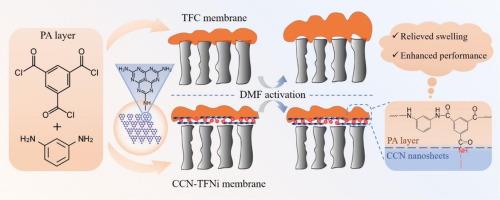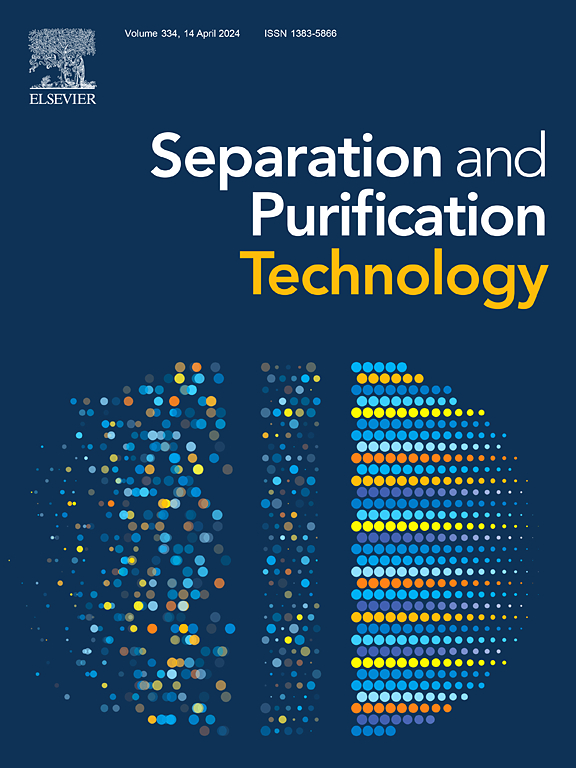用于增强有机溶剂纳滤的坚固氮化碳纳米片夹层薄膜纳米复合膜
IF 9
1区 工程技术
Q1 ENGINEERING, CHEMICAL
引用次数: 0
摘要
在薄膜复合膜中整合纳米材料夹层可显著提高其在有机溶剂纳滤(OSN)中的性能。然而,由于在不同溶剂中的溶胀行为不同,这种增强往往以牺牲膜的完整性为代价。在本研究中,我们利用绿色、多孔、活性结晶氮化碳(CCN)纳米片作为功能性夹层,提出了一种既能表现出高渗透性又能保持稳定的夹层薄膜纳米复合(TFNi)膜。结果表明,由于 CCN 中间膜的存在,即使在 DMF 暴露 10 小时后,膜仍能保持对有机染料的排斥性,而 DMF 处理则显著改善了有机溶剂的渗透性。CCN-TFNi-DMF 膜的甲醇渗透率达到了惊人的 8.77 L m-2 h-1 bar-1,在 10 bar 压力下的 72 小时测试期间保持了稳定的性能。我们将这一性能提升归功于 CCN 纳米片引入的额外纳米通道提高了 TFNi 膜的渗透率,以及在界面聚合过程中 CCN 纳米片表面的氨基与三甲酰氯反应形成稳定的聚酰胺膜。这项工作为开发性能优异的结构增强 TFNi 膜提供了宝贵的见解,可用于 OSN 分离应用。本文章由计算机程序翻译,如有差异,请以英文原文为准。


Robust carbon nitride nanosheet interlayered thin-film nanocomposite membrane for enhanced organic solvent nanofiltration
The integration of a nanomaterial interlayer within a thin-film composite membrane can markedly enhance its performance in organic solvent nanofiltration (OSN). However, this enhancement often comes at the expense of membrane integrity due to differential swelling behaviors in diverse solvents. In this study, we present an interlayered thin film nanocomposite (TFNi) membrane that demonstrates both high permeance and robust stability, utilizing green, porous, and reactive crystalline carbon nitride (CCN) nanosheets as the functional interlayer. The results revealed that ascribed to the presence of the CCN interlayer, the membranes retained their rejection towards organic dyes even after 10 h of DMF exposure, while the organic solvent permeance was significantly improved by the DMF treatment. The methanol permeance of the CCN-TFNi-DMF membrane reached an impressive 8.77 L m−2 h−1 bar−1, sustaining stable performance throughout a 72 h test period under a pressure of 10 bar. We attributed this performance enhancement to the extra nanochannels introduced by the CCN nanosheets that bolstered the permeance of the TFNi membrane, as well as the formation of a stable polyamide film resulting from the reaction between the amino groups on the CCN nanosheet surface and trimesoyl chloride during the interfacial polymerization process. This work provides valuable insights into the development of structurally reinforced TFNi membranes with exceptional performance for OSN separation applications.
求助全文
通过发布文献求助,成功后即可免费获取论文全文。
去求助
来源期刊

Separation and Purification Technology
工程技术-工程:化工
CiteScore
14.00
自引率
12.80%
发文量
2347
审稿时长
43 days
期刊介绍:
Separation and Purification Technology is a premier journal committed to sharing innovative methods for separation and purification in chemical and environmental engineering, encompassing both homogeneous solutions and heterogeneous mixtures. Our scope includes the separation and/or purification of liquids, vapors, and gases, as well as carbon capture and separation techniques. However, it's important to note that methods solely intended for analytical purposes are not within the scope of the journal. Additionally, disciplines such as soil science, polymer science, and metallurgy fall outside the purview of Separation and Purification Technology. Join us in advancing the field of separation and purification methods for sustainable solutions in chemical and environmental engineering.
 求助内容:
求助内容: 应助结果提醒方式:
应助结果提醒方式:


